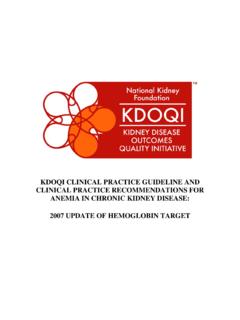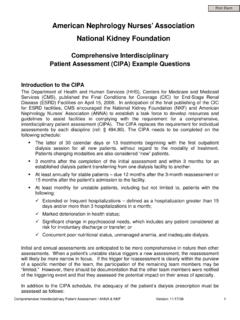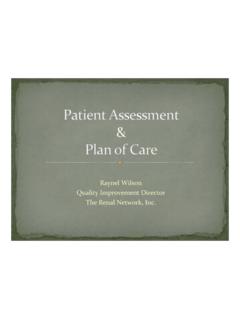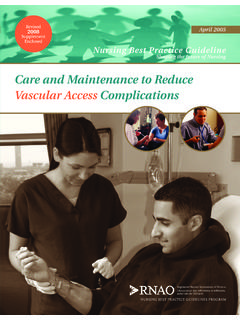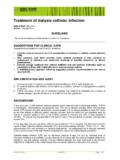Transcription of Objectives AV Fistula Maturation, z - The Renal …
1 AV Fistula maturation , Cannulation, and ProtectionLesley C. Dinwiddie MSN, RN, FNP, CNNO bjectivesThe learner will be able to:zDefine AV Fistula maturationzDescribe the nephrology caregivers role in maintaining AV fistulaszDescribe the components of an AV Fistula physical assessmentzSummarize tips suggested for successful cannulationzDiscuss rationale for vascular access surveillanceWhat are the KDOQI guideline %s for Fistula prevalenceThe 2006 update for the KDOQI guidelines say that >65% of prevalent patients should have a functional AV fistulaThe Clinical Performance Measures (CPM) defines a working Fistula as one that can be used for a dialysis treatment with 2 needlesThe Fistula First Breakthrough Initiative (FFBI) says that the target % for prevalent working fistulasis 66% of all access !How the Vascular access Team can increase % of working fistulas especially the nurses role in Fistula First Breakthrough InitiativeThe Fistula First Breakthrough Initiative (FFBI) is working on both the nephrology, surgical and interventional barriers to Fistula creation and preservation with the physicians!
2 How well are we doing with the staff and patient education with Fistula protection, maturation , and cannulation? Is cannulation the overlooked variable? We all know that fistulas ARE the best access because they have fewer complications once established!However, if we don t get a handle on effective, consistent assessment & cannulation, we will continue to struggle to establish and maintain AVFs!Types of FistulasSimple (radiocephalic & brachiocephalic)Vein transposition (BVT & CVT)2 step - simple then transposition*Superficialization of veins by surgical removal of tissue between skin and veinPost-surgical assessment every*treatment!Overall appearance: edema, hyperemia (redness), bruising, functional abilitiesSkin: incisions (?presence of stitches, staples or drainage), appearance of outflow veinPulses distal to fistulaDigits; temperature, capillary refillThrill and bruit along the outflow veinArterio-venous fistulasbasic care zmaturation exercises (2 weeks postop)zprotecting the access (from day 1)zno IV sticks in that armzno BP cuff (which is why you check at every treatment)zno tight clothing or jewelry that binds zTeach patient to not sleep on his Fistula armzholds own needle sites (after cannulation begins)
3 Zremoves pressure dressings ASAP zongoing physical assessment, flow and pressure monitoringArterio-venous fistulaecomplicationszinadequate maturationzrepeated infiltrationzsteal syndrome or nerve damagezstenosiszthrombosiszinfection zaneurysms/one site-it iszhigh flow vein hypertrophyFistula MaturationExercises - might help*, shouldn t hurt but patients should not be told that exercising WILL make the vein larger and WILL prevent early failure research is limitedIf I can hear bruit to the elbow with an RC AVF or shoulder in a BC Fistula at 2 weekspostop - it s a good sign that the vein will develop (but not guaranteed)Exercise should both enlarge the vein by increasing flow and build the muscle below to make the vein more prominentFistula MaturationVeins not large enough to cannulate at 6* weeks should be referred to surgeon or interventionalist - there may be collaterals that can be tied off or a fistulogram* may detectstenosis that could be plastied for better flowThe Fistula itself may need to be revised surgically or recreated more proximally on the arteryIs the artery integrity and cardiac output adequate to expand vein?
4 Rule of Three 6s for the VeinGreater than 600mL per min flowGreater than 6 mms in diameterLess than 6mms below skin surfaceANDAll fistulae should be thoroughly examined no later than 6 weeks post opMaturation TimeHow long should you wait till cannulation attempt?zin Europe they say 4 weeks that there are no more complications than waiting 8-12 weekszin the US the general wisdom is 8-12 weeksShouldn t it depend on the individual patient s vein development, alternative access situation, and the cannulation expertise of the staff?*Physical AssessmentBefore EVERY cannulation regardless of AVF age! inspectionzgeneral developmentzskin conditionz? aneurysmsz? hyperpulsatility (look for collapse of outflow vein with arm elevation)palpationzthrill or pulsationauscultation -quality and amplitude of bruitDoes Cannulation Affect Outcomes?One-site-itis leads to aneurysm formation that may requiring ligation of the Fistula outflow veinShould a clotted access be stuck to make sure?
5 Infiltrations - should they be considered a fact of access life? Compartment syndrome?Should an outflow vein be cannulated if recently severely infiltrated? access Infections - do bacteria get a free ride from the careless cannulator?The Marginal Outflow VeinUse a small, single needle initiallyAggressively treat infiltrationsConservatively recannulateGet ultrasound mapping for depth and sizeGet fistulagram if generalized swelling occurs*Refer back to surgeon for revision optionsPatient PreparationCannulation will be more successful, more of the time if you have a relaxed, confident patient:zPain is minimized with relaxation of the musclesz? Local anesthesia using zLidocaine/prilocaine creamzEthyl chloridezLidocaineis a must for the fearful patient until such time as the pain is diminished with trust and scar tissuePatient You know you have to be careful not to make them mad or get a reputation for being a trouble maker then they might stick you or infiltrate your vessel on purpose.
6 You know that s happened. I know cases where that s happened where technicians have done that. Curtin & Mapes (2001) Health Care Management Strategies of Long-term Dialysis Survivors P389 NNJ, 28(4) Cannulation TechniquesRope ladder technique to assure rotation of sites and prevent one-siteitisfor grafts and fistulasORButton Hole technique for fistulasUse of a single needle at firstSelect your best cannulatorChoose a 17 gauge needleUse for arterial return to catheterTo prevent prolonged bleeding or large infiltrationzFlush and heparin lock the side of catheter not being used early in treatment - ?locking strengthzReduce loading dose zTurn off heparin at least 1 hour prior to takeoffButton Hole TechniqueIs the repeated cannulation into the exact same puncture site, and a scar tissue tunnel tract develops. The scar tissue tunnel tract allows the needle to pass through to the (outflow) vessel of the Fistula following the same path each time.
7 Patt Petersen, Medisystems Button Hole TechniqueCannulation less painfulQuick and easy cannulationInfiltrations and reneedling virtually eliminatedInfection rate not significantly higher than multi-site cannulationTwardowski, D&T,1995 For more information on the buttonhole go to: ControversiesTourniquet in the mature Fistula ?Wet stick or dry stick? (infection vs clotting in the needle)To clamp or not to clampWho are the cannulators?Who is the Cannulator?Will just anyone do?Would you let that person stick you or yours?What training should you look for?Is there a role for dedicated cannulators*?Has the time for self-cannulation arrived? Variability of Staff ExperienceHigh staff turnover with many new staff having NO cannulation experience!Do technical staff being trained to cannulate have a basic understanding of anatomy & physiology?Many staff trained to cannulate PTFE try to cannulate outflow veins with same techniqueAre cannulation challenges assigned to appropriate expertise?
8 Self-CannulationThese patients tell mezthey are not masochists - they choose to self-cannulate because it is the lesser evil zthey never hurt themselves (can you tickle yourself?)zthey rarely miss (infiltrate)Teaching tip: show the patient how to stick himself with a small (21g or less) butterfly the first time on a non-dialysis day in a non-threatening atmosphere & locationLesley s cannulation tipscarefully inspect, feel, and listen to accessthoughtfully choose BOTH needle sites before inserting - take your timezwhich side/end is arterial*?zwhere was the previous cannulation site?zis there room above to insert again should it not work?zwhere will the tip of the needle be?zhow deep is the vessel?z? needs local - lidocaine versus Emla creamLesley s cannulation tips your timezvein and graft walls have different compositionzALWAYS use a tourniquet for a fistulazuse a tourniquet for a mushy graftzfistulas not as tough as PTFE - be gentle!
9 Zif at first you don t succeed - get expert helpzstick unto others as you would have them stick youLesley s cannulation tips don t bend - accesses dozrotate sites (unless there are buttonholes)zlisten to your patient - he s seen the best and the worst and knows his access bestzflip needles ONLY if flow is poorztape needles securely not tightly ztake your timePatient quote How is it that they have enough time to stick me 2 or 3 times when they miss - but don t have enough time to do it right the first time? Post-Dialysis access AssessmentShould mirror pre-dialysis for patency and condition noting any significant changes from the pre-dialysis assessment (therefore should be done by the same caregiver if at all possible)zpresence of hematomazpresence of painzlength of time to hemostasis (noting any anticoagulation influences)zcharacter of thrill and bruitUltrasound AssessmentDirection of flowCan detect stenosisSize of vessel Depth of access get serial depthsRequest a map and possible marking of skin over vesselGet a Site-rite for your unit!
10 Vascular access MonitoringEffective zmust get donezmust minimize false positives - cost & inconveniencezmust minimize false negatives - loss of accessAffordableUser friendly - see #1 Rational - what are we looking for?Prospective identification ofstenosesFlow studies trendsStatic venous pressure (VP0) trendsVenous dialysis pressure (VDP) trendsOther signs and symptoms of access pathologyzrecirculation and/or decreased URRzdifficulty cannulating and pain in the accesszchanges in thrill and bruitzprolonged bleeding post-dialysiszarm swelling & prominent collateralszsudden appearance of aneurysmsMechanical SurveillanceFlow monitoringStatic venous pressuresDynamic venous pressuresPrepump arterial pressuresBlood volume processed (BVP)Online clearance monitoringAll to prospectively identify stenoses!Best Practice access Monitoringsecond generation K/DOQI guidelines (#10)clinical performance measures (CPMs)keep using your own assessment skills -don t get machine-reading dependent -remember tozUse all your senses for assessment and then use your memory to compare and contrast the condition of the access to previous assessmentszListen to what your patient says!
